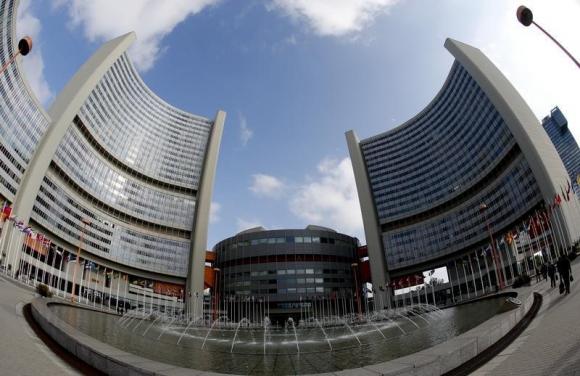[caption id="attachment_101660" align="alignright" width="220"] The United Nations headquarters building (Vienna International Centre) is pictured in Vienna May 14, 2014.[/caption]
The United Nations headquarters building (Vienna International Centre) is pictured in Vienna May 14, 2014.[/caption]
(Reuters) - A U.S. security institute estimates that Iran could amass material for a nuclear bomb in three months or less while Iranian experts cite a time frame six times longer - a dispute going to the heart of talks between Tehran and global powers.
Differences over how fast Iran could "break out" a nuclear weapon complicate the quest for a deal by late July under which Iran would scale back its atomic energy programme in exchange for a lifting of crippling sanctions.
The West wants Iran to significantly cut back its uranium enrichment capacity to ensure it would not be able to quickly produce a nuclear bomb. Iran says it needs to expand its programme to fuel a planned network of atomic energy plants, denying accusations of a secret nuclear weapons agenda.
With only some five weeks to go before the self-imposed July 20 deadline for a deal, the negotiating positions between Tehran and the United States, France, Germany, Russia, China and Britain remain far apart. A fifth round of talks since February is being held in Vienna this week.
U.S. Secretary of State John Kerry has said that Iran has the ability to produce highly-enriched uranium for one bomb in two months, if it so decided. [ID:nL6N0N010U] Western officials and experts say this potential timeline must be substantially extended under any deal to end the decade-old nuclear dispute.
In an apparent attempt to counter that view, an Iranian website this month published a report saying it would take at least 18 months to do so, a time frame that would reach three years if conversion of the material into uranium metal and moulding - steps required to make a bomb - were included.
Yet more time would be needed to develop a vehicle, a missile for example, for a nuclear warhead to be delivered to its target.
"It is impossible for Iran to break out in months through the uranium route. The required time span is in years," the report published on www.nuclearenergy.ir said, stressing that this was a "hypothetical" scenario.
The website says it is "dedicated to providing accurate and factual information" about the Iranian nuclear programme, which the Islamic Republic says is entirely peaceful.
NUCLEAR BREAKOUT "MYTH"
The Institute for Science and International Security (ISIS), a U.S.-based think-tank which closely monitors Iran's atomic activities, said on Wednesday that the Iranian website "expresses common government stances" on nuclear issues.
"This study contains mistakes and uses unwarranted assumptions to arrive at its conclusions," ISIS said of the Iranian report. "Using its data and correcting for mistakes, we arrive at a breakout estimate of 2-3 months in terms of the time to produce 25 kg of WGU (weapons-grade uranium)." That is the amount traditionally seen as sufficient for one bomb.
Uranium enriched to a fissile concentration of around 5 percent is used to fuel civilian nuclear power plants, Iran's stated ambition. If processed to a much higher degree, to about 90 percent, it can provide the fissile core of a nuclear bomb, which the West fears may be Tehran's covert aspiration.
Iranian Foreign Minister Mohammad Javad Zarif, the country's chief nuclear negotiator, criticized what he called the breakout "myth".
"For years, small but powerful constituencies have irrationally advanced the idea that Iran can produce enough fissile material for a bomb in months," he said in a June 13 article for the Washington Post.
If Iran ever wanted to take such a step, he said, it would have to expel U.N. nuclear inspectors and reconfigure its enrichment programme to make weapon-grade fissile material, which would then need to be turned into metal and "undergo countless other complex weaponisation processes".
"None of these capabilities exist in Iran and would have to be developed from scratch. This would take several years — not a few months," Zarif said.
By Reuters
The Iran Project is not responsible for the content of quoted articles.

 QR code
QR code